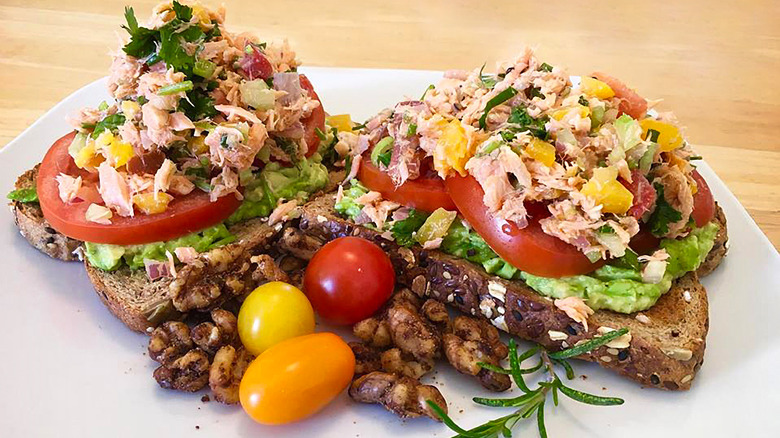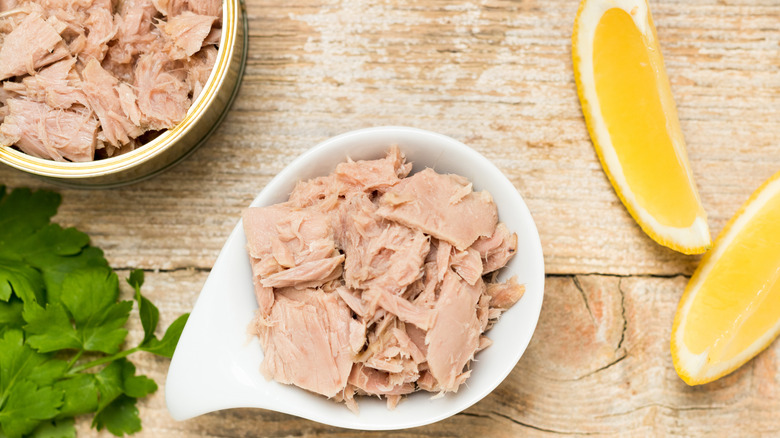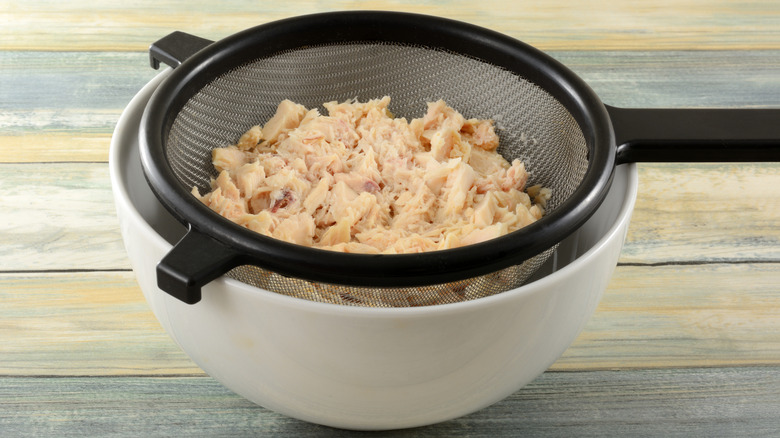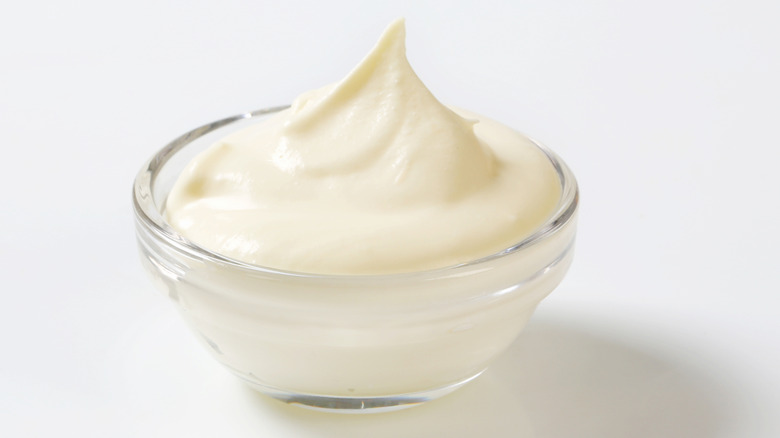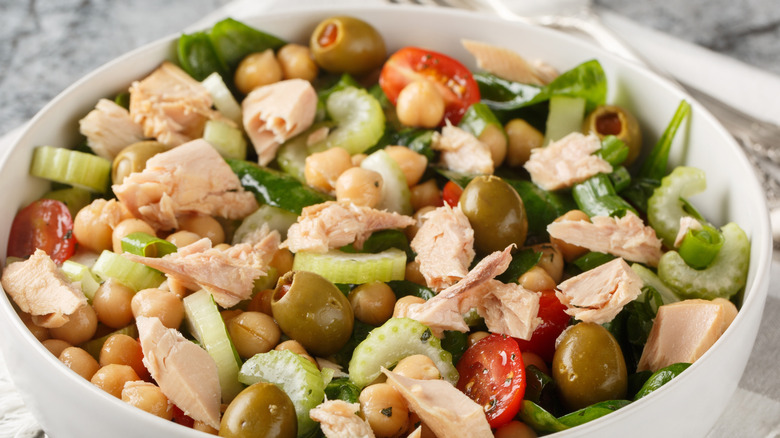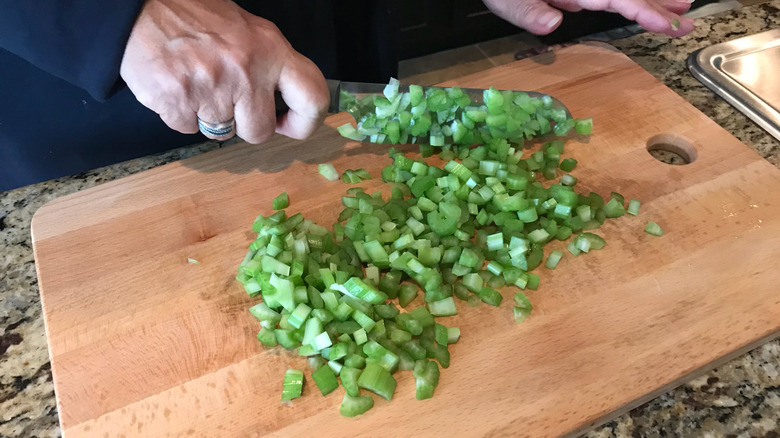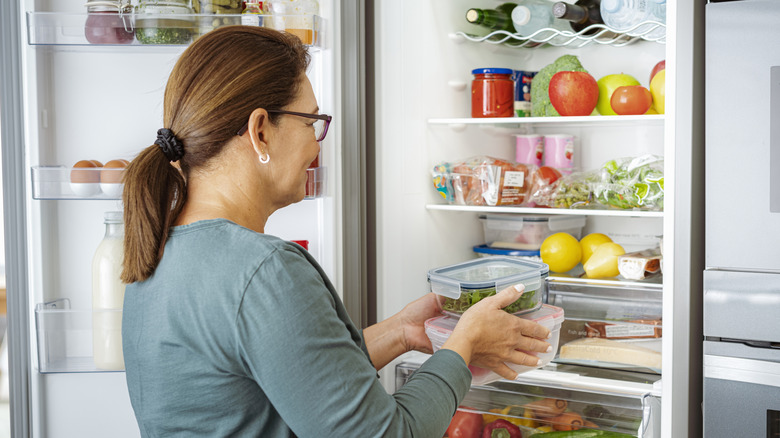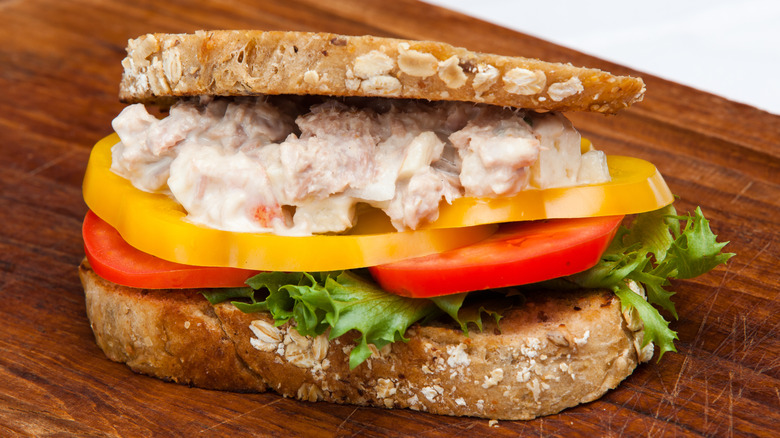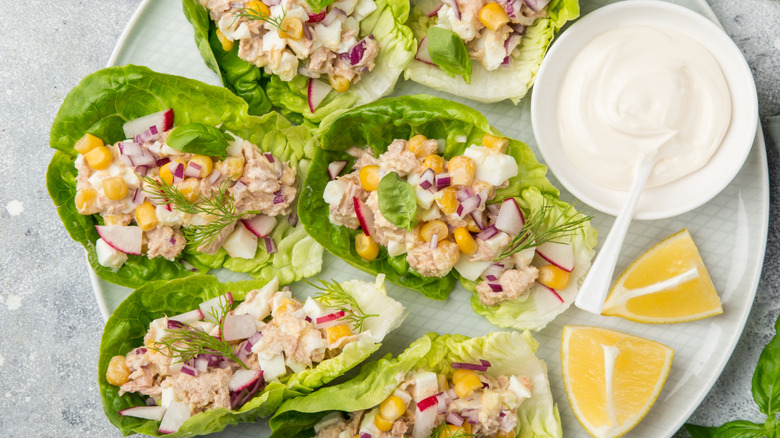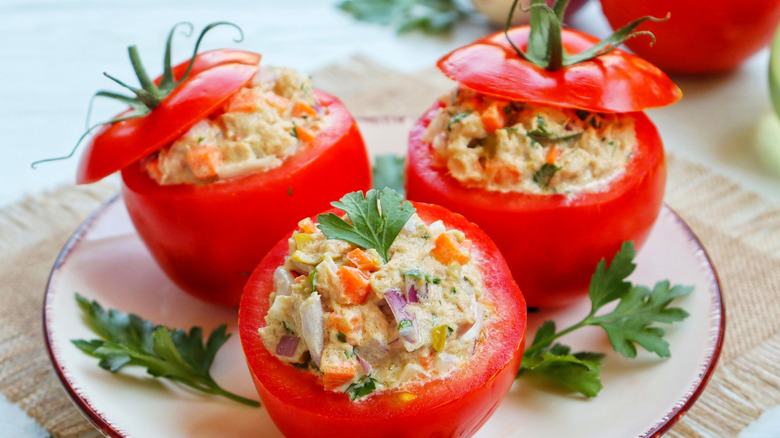Why Restaurant Tuna Salad Is Almost Always Better Than Homemade
From Duke's versus Hellman's to avocado versus Dijon, the debate about the best ingredients for tuna salad has lasted for decades. One thing remains clear in the great tuna salad quest — no matter what you mix it with, season it with or add to it, restaurant-made tuna salad reigns superior.
It took time — maybe desperate times — for tuna to rise to its fame. In the 1800s sardines were the chosen consumable canned fish. Tuna, on the other hand, was commonly used as bait or cat food. But when poor fishing conditions created a sardine scarcity, they went looking for substitutes and tuna, thanks to a hefty marketing campaign, got the lead role. Declared a popular food in 1913, tuna soon began being served not only in salads at lunch counters but as a delicacy at finer restaurants.
Today, many of us continue trying to spin up a version of our favorite restaurant's tuna salad, but the truth is, it's a tough battle to win. There are several reasons why even the most gourmet (capers and fresh Parmesan cheese anyone?) or basic (celery, salt and mayo) tuna salads created in restaurants dominate the homemade version.
High-quality tuna
While some might debate which ingredient is truly the star of tuna salad, let's assume it's the tuna. Most home chefs shop for their tuna in the canned foods section of the grocery store, often deciding between albacore, chunk light, and oil versus water packed. Restaurants, on the other hand, often source higher-grade tuna. Some chefs prefer fresh tuna, bought directly from a fisherman or at a market. Using fresh tuna in tuna salad contributes both to the flavor (no subtle notes of metal), as well as the texture, since fresh tuna is thicker and meatier than the canned version. Cooking methods for fresh tuna with a destination in a tuna salad vary from pan searing, baking or grilling.
Restaurants that opt for the canned version typically select premium grade tuna, sometimes the imported type, and usually albacore which has a firmer, meaty consistency and less fishy flavor than the chunk light. Generally, restaurant chefs prefer canned tuna packed in oil versus water. Oil tends to mask the overly fishy smell, carry a richer flavor, and its tender texture tends to bind more to the other salad ingredients. As far as choosing a high quality canned tuna, there are a lot of options and some canned tuna ranks better than others.
Better drained tuna
It seems almost ironic that tuna packed in water or oil actually tastes better in salad when it's completely drained. But the reality is, no one really likes watery, drippy salads or a soggy sandwich. The purpose of the liquid in the can is to preserve the fish rather than enhancing its flavor. Draining the water or oil also makes the tuna a little healthier; after all, oil has a lot of extra fat, and tuna in water is also packed with sodium.
Michael Ruggeri, co-owner of Archie's NY Deli in Boston explains, "Squeezing the tuna as dry as possible so it can take on the flavor of the dressing is probably the biggest reason why restaurant tuna tastes better."
To properly drain a can of tuna, you have two options. You can take the easy way, open the lid most of the way, flip the can upside down, press on the lid, and let the liquid drip out. Alternatively, you can plop the tuna into a colander and press down to drain the liquid. It's also helpful to pat the tuna with a paper towel to soak up any extra moisture. The second option creates a bit more mess and at least one dish to clean — something restaurant chefs are very accustomed to but home chefs may try to avoid.
Richer mayo
Mayonnaise is one of those love-it or hate-it ingredients, but it's also probably the most common addition for tuna salad. If you've ever walked through a restaurant kitchen, you've probably seen the gallon-sized containers of mayo.
While many chefs opt for store-available brands like Duke's and Hellman's, what differentiates most restaurant mayo varieties from what you may have in your fridge is that professional chefs prefer heavy-duty mayonnaise. The makeup of mayo is pretty simple — typically eggs, oil and an acid like vinegar or lemon. What sets heavy-duty mayo apart is extra egg yolks which bulk up the creamy consistency as well as the flavor. The richer texture in heavy-duty mayo also keeps the tuna salad from getting watery.
The mistake many of us make when buying basic ingredients is letting price dictate our selection. This is where we might opt for the store-brand mayo or the mayo dupes like Miracle Whip. When mayonnaise is the main binding ingredient and you're going for the restaurant-worthy tuna salad, splurge for the bigger brands and higher quality ones rather than the cost-conscious wannabes.
But for those who can't stand the thought of mayo gracing their fridges, let alone their tuna salad, there are other acceptable substitutes like Greek yogurt which presents a similar creamy, thick consistency to mayo. Other popular alternatives include mustard (both yellow and Dijon), hummus, avocado, or simply olive and lemon juice.
Less adherence to unhealthy add-ins
Whether it's mayo or yogurt, most restaurant chefs are more relaxed and less restrictive when it comes to fat and sodium content in a recipe, prioritizing flavor over calories, carbs, and macros. Those who cook from scratch at home often look for healthier recipes or precisely follow ingredients in a recipe, adding just a ¼ teaspoon of salt versus restaurant chefs who are cooking large batches and let taste dictate what the right amount ends up being. The tuna sandwich at Panera Bread, for example, packs a whopping 1,670 milligrams of sodium, which is close to the daily sodium threshold for most adults.
Due to the extra eggs, the fat content in heavy duty mayo far outpaces even the full-fat versions of both Hellman's and Duke's. If you're not too concerned about fat and sodium intake, and you're really going for the restaurant replica of tuna salad, you can try making your own version of heavy-duty mayo by adding extra egg yolks to your regular mayo. Just be sure to do this before adding in any other ingredients. Then take it up one more notch by saving the salt until the end and shake until you strike the perfect flavor rather than following a recommended amount.
Creative ingredients and flavor combos that complement each other
While traditional tuna salad usually calls for tuna, mayo, onion, and celery, there are hundreds of variations to this classic combo, making it fun to see each restaurant's spin on tuna salad. Restaurants with tons of ingredients, herbs, spices, and sauces on hand, are like a laboratory for tuna salad experimentation. For a spicy flair, some might want to add tabasco, jalapeños, or sriracha. At one Mediterranean restaurant in Connecticut, the combo includes chickpeas, black olives, and feta.
When it comes to herbs, restaurants are more likely to use fresh herbs on hand year-round –- from dill to oregano, basil, and paprika–these fresh herbs tend to give a more powerful flavor over the dried herb jars most of us have stocked in our spice cabinets. Springing for fresh herbs in tuna salad over dried not only enhances the flavor, but also ensures you aren't tainting your tuna salad with expired ingredients.
Many chefs look for creative ways to amp up the crunch factor when serving tuna salad. Order at the Neiman Marcus Cafe, and you'll discover an enhanced crunch with the pecans and water chestnuts added in. If you have extra potato chips on hand, add them as a crunchy layer between the bread and salad on a tuna sandwich. Chef and cookbook author J. Kenji-Lopez Alt prefers salt and pepper flavored chips, but any chips will do. Not only does it add crunch, it can also help hold the salad in place and prevent slippage out of the sandwich.
Consistent chopping and texture
Size matters when it comes to tuna salad ingredients, so it's important to strike just the right balance between not too big and not too small. If tuna, for example, is left too chunky and far outsizes the other ingredients, it'll be distracting and hard to get the variety of flavors in one bite. Mince everything up too teeny tiny, and you'll lose the crunch and flavor pop that a variety of ingredients should deliver. Even the texture of the tuna is important. Using a fork to flake it is best so you can work out any lumps and chunks.
Most chefs recommend dicing all your ingredients in order to make your tuna salad just right. Restaurants have the tools and expertise to achieve chopping that's consistent, lending to a salad that holds together well. Once you have all your right-sized ingredients in a bowl, be careful not to over mix to where the salad becomes mushy, losing its crunch and its punch.
Chill and merge flavors
Let's be honest, once you've gotten to the stage of mixing up all the ingredients, maybe even as you sprinkle your salt and pepper, it's time to give your salad a taste. Typically, when we're making tuna salad at home, we're ready to plate it up, spread it across that slice of bread and eat it rather immediately. But one of the key differentiators between restaurant tuna salad and homemade is chill time.
Restaurants often prepare their tuna salad in large batches and store it in the fridge for days. It's this extra time that allows the flavors to blend and be absorbed. If you can resist, let your salad rest in the fridge for at least a few hours, if not overnight, and you'll come closer to that restaurant-level taste.
A few other steps chefs take to create that perfect chilled flavor? Storing the unopened canned tuna in the fridge, as well as the other ingredients you're adding to the salad before you start assembling. Take it one step further, and get the bowl you're prepping your salad in good and cold by sticking it in the freezer or fridge in advance.
Soggy sandwich stoppers
When you're adding mayo, oil, lemon, and other wet ingredients to your tuna salad, how do you prevent it from being a sloppy, soggy mess? It comes down to bread choice. Think about the nostalgic, Saran-wrapped white bread soaked tuna salad sandwich you may have been handed in the cafeteria line in school. After unwrapping it and taking your first bite, you may have found yourself in need of more napkins as the ingredients oozed out of the bread. To avoid this mess and give your salad a sturdier container, most restaurants opt for heartier bread options such as multigrain, sourdough, or rye. Restaurants are more likely to have fresh bread on hand which can also be a difference maker.
Toasting the bread can also not only keep the salad in place but add another crunchy dimension to your salad. Restaurants often throw the bread on the griddle striking the perfect crispiness, and when melted cheese is included and it oozes and sticks to the outside diners rave, like at New York's S&P Lunch. One other trick restaurants follow is making tuna salads on demand so it's not over-saturating the bread by sitting on it too long.
On a quest to find the best tuna sandwich? Check out this list.
Beyond the bread
While sandwiches are by far the most common way restaurants serve tuna salad, it's definitely not the only. Another popular vehicle for tuna salad — besides bread -– is lettuce. But not just any lettuce. Most professional chefs recommend bib lettuce or a crispy romaine. Like the bread, lettuce should be sturdy enough to contain the salad, and these crispier lettuce types give the salad extra crunch.
Some restaurants serve tuna salad with a side of crackers, crostini, or tortilla chips. But veggie lovers may prefer the tomato stuffed with tuna salad. Think of a stuffed pepper but swap the pepper for a tomato, remove the top, scoop out the seeds and flesh, and then fill the cavity with your tuna salad. Stuffing peppers and avocados with tuna salad are other popular low-cal ways to serve tuna salad. Some restaurants take these dishes a step further, topping with cheese and sitting under the broiler — tuna melt meets a tomato.
Finishing touches
When fixing sandwiches or salads at home, especially for ourselves, most of us don't give too much thought to the aesthetics. Instead, we're often trying to assemble ingredients and fill our plates as quickly (and oftentimes sloppily) as possible. The heel of the bread or floppy exterior leaves of iceberg lettuce often make appearances because that's what's available in our kitchen. But it's not how the professionals fix their tuna salad.
Restaurants know that presentation is often a way to win back customers, so they take the time to chill their plates ahead of piling on the colorful and cleanly cut salad ingredients or stacking and cutting sandwiches to make them photo-worthy. And how many of us think of adding garnishes like a fresh sprig of parsley, neatly sliced strawberries or a few perfectly shaped olives on the side?
In addition to the type of tuna, fresh ingredients, and higher quality mix-ins, the reality is that restaurant tuna salad often tastes better simply because of its presentation. After all, if you're eating a chef-made version, you don't have to do the shopping, chopping, and worrying about the cleanup. All of this contributes to making the overall experience of eating tuna salad made by a restaurant taste better.
